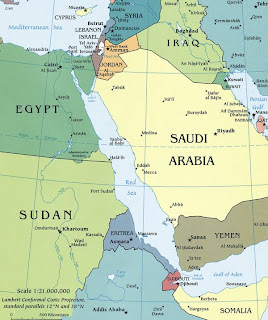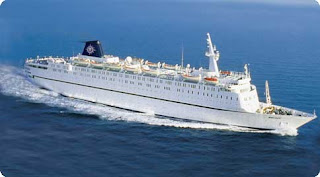 Missile defense ought to be in the forefront of national defense.
Missile defense ought to be in the forefront of national defense.The threat is not from the traditional major powers. Nor is missile defense a means of defending against retaliatory strikes after a first strike.
Instead the threat is the "one off" missile filed by a rogue state or a stateless entity like al Qaeda. A retaliatory strike capability is pointless if there is no one to retaliate against. Against the rogue state or stateless actor the best alternative to be able to thwart the attack.
Now comes a compelling argument by Claremont Institute's Vice President and Fellow in American Studies, Larry Greenfield, for missile defense systems here:
Modern missile technology, in the hands of terror states and their proxies, threatens.Some argue that missile defense money spent is money wasted, for example Missile Defense: 'Longest Running Scam' Exposed:
The next level of national security advocacy has therefore arrived as well.
It is the public campaign for funding and deployment of missile defense systems against rogue states and terror groups who are not deterrable by the threat of counterstrike or mutually assured destruction.
***
Put more broadly, can Western democracies, including the United States, preempt or defend attacks before a crisis develops, rather than merely planning and preparing to retaliate while meekly surviving post-disaster as a destroyed nation?
***
Test after successful test of anti-missile missiles shows that President Ronald Reagan’s original vision of missile defense — not the immoral and limited option of massive retaliation — has become attractive both in the United States and Europe. Poland and the Czech Republic are logical sites for radar and system deployments. However, President Barack Obama’s recent European tour did not give our friends confidence that he would continue our path to defend Europe.
***
Several important developing U.S. missile defense projects all face looming budget cuts, including the Airborne Laser, a “boost phase” defense, which counters North Korean or Iranian long-range missiles; the Ground Based Interceptor program (our only operational system capable of destroying a Taepodong-2 missile approaching the U.S. mainland); the Multiple Kill Vehicle, designed to destroy multiple missile stages and warheads in space; and the Space Tracking and Surveillance System, which discriminates between real warheads and decoys in space, thereby defeating an enemy’s ability to overwhelm our missile defense system with countermeasures.
Missile threats are real and missile defense science is solid. The funding costs are actually quite low and the moral case is overwhelming. Political obstacles must be overcome, including the left’s rejection that the U.S. would be strong or independent in the world and the military establishment’s repeated bureaucratic resistance to using funds for projects that aren’t their own.
Dr. Stephen Flynn, Senior Fellow for National Security Studies at the Council on Foreign Relations and a retired Coast Guard Commander, testified that the "non-missile risk" - smuggling a weapon of mass destruction into the US by ship, train, truck, or private jet - is "far greater than the ballistic missile threat...." He noted that smuggling is the only realistic option for a terrorist group like al Qaeda; it offers anonymity to any attacking nation and therefore protection from retaliation; seaports, borders, and overseas flights "provide a rich menu of non-missile options"; and it has greater potential to "generate cascading economic consequences by disrupting global supply chains."Gee, maybe there can be more than one kind of threat. And there has been recent evidence of North Korea and Iran building up their missile systems. While they may be crude, they still work. Sort of like the AK-47.
Despite these risks, Flynn said, "The combined budgets for funding all the domestic and international port of entry interdiction efforts... is equal to roughly one-half of the annual budget for developing missile defense. Nowhere in the US government has there been or is there now an evaluation of whether that represents anappropriate balance....The amount of resources we dedicate to the [more serious threat of cargo delivery] is miniscule compared to the kinds of resources we invest in dealing with the ballistic missile threat. That's the kind of disconnect we're operating in."
A while ago I did a post on the potential threat from the sea based missiles which is worth a look:
The U.S. Navy is now standing up the Air and Missile Defense Center (NAMDC) as described by Steeljaw Scribe:Now that's a real threat -- one we should take seriously.This concept has been covered before- at The CounterTerrorismBlog here:Reader TimothyOther relevant links here ("Iran's New Missiles"), here ("Iran's Cruise Missile Threat and Merchant Ships") and all the links therein. And remember that SecDef has mentioned this scenario before:Thompson, who is always able to provide keen insight into weapons systems, comments on the missile purchase:
[The BM-25 missiles that Iran purchased] can easily be launched from [a] freighter modified with launch tubes and blast channels. They give Iran a projection of force capability far beyond the 2000-3000 km range of the missiles. It is possible -- though not confirmed -- that Iran may not use the BM-25's but only bought them to get the R-27 rocket motors for a missile of their own design.Mr. Rumsfeld also was asked about the danger of terrorists or rogue states attacking the United States by putting a short-range Scud-type missile on a freighter and firing it close to U.S. shores.As long as I'm repeating things, go visit MissileThreat.com at the Claremont Institute and enjoy their movies of a merchant ship launch here (big) or here (smaller) to see how it would work.
He said one Middle East nation already has “launched a ballistic missile from a cargo vessel.”
“They had taken a short-range, probably Scud missile, put it on a transporter-erector launcher, lowered it in, taken the vessel out into the water, peeled back the top, erected it, fired it, lowered it, covered it up. And the ship that they used was using a radar and electronic equipment that was no different than 50, 60, 100 other ships operating in the immediate area.”
Other U.S. officials have said the nation was Iran, which tested a freighter-launched missile in the Caspian Sea in the late 1990s.
“It is true that the big distinction we make between intercontinental, medium-range and shorter-range ballistic missiles doesn’t make a lot of sense if you’re going to move the missile closer to the target,” he said. (source)
On Thursday, 30 April 2009, the Navy’s newest Center of Excellence (COE), the Navy Air and Missile DefenseCall your Congress person and ask for more money for these programs.Center, was opened for business onboard the Naval Weapons Development Center, Dahlgren Virginia. RADM Brad Hicks, who is also the Aegis BMD program director, will serve as the Center’s first commander until a permanent flag is assigned later this year. The ceremony’s keynote speaker, ADM Robert “Rat” Willard, Commander U.S. Pacific Fleet spared no words in underscoring the importance of this particular COE in the context of recent events to include the recent North Korean launch.
***
The challenge ahead of the center will be the role it plays in Navy’s quest to equally field a national missile defense to shield the homeland, a regional defense for friends and allies and theater systems for protection of forward deployed forces while still accounting for the multi-mission nature of platforms like the Aegis-equipped cruisers and destroyers currently deployed. And the center’s efforts won’t end there, for the threat includes ever-increasingly proliferated cruise missiles and a host of other airborne threats.
***
This was a much needed step in beginning to restore balance to a force that has, frankly, become very power projection-centric. Along with other warfare areas, such as blue-water ASW, it seemed in the post-Cold War environment that integrated air and missile defense was increasingly pushed to the back even while threats like those posed by new generations of low-observable, fast cruise missiles were widely proliferated. However, the emerging area denial capabilities of countries like China and Iran, not to mention the requirements levied by the Maritime Strategy (and, one presumes, the NOC when it ever is released) clearly demand the establishment of an organization to oversee the disparate parts of the air defense picture.






































